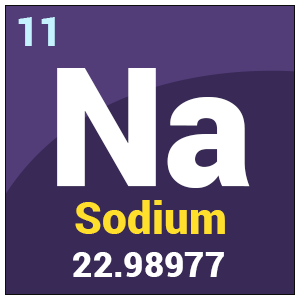

Once liquid, sodium hydroxide leaches rapidly into the soil, possibly contaminating water sources. Sodium's powdered form is highly explosive in water and a poison combined and uncombined with many other elements.Įcotoxicity: Median tolerance limit (TLM) for the mosquito fish, 125 ppm/96hr (fresh water) Median tolerance limit (TLM) for the bluegill, 88 mg/48hr (tap water).Įnvironmental fate: this chemical is not mobile in solid form, although it absorbs moisture very easily. Contact with eyes may result in permanent damage and loss of sight. You can read other jokes specific to certain topics, like Mole Day. Some of them are groaners, but some are quite funny.
Sodium element sybole skin#
Contact to the skin may cause itching, tingling, thermal and caustic burns and permanent damage. Here is a collection of reader-submitted chemistry jokes and puns. Very severe exposures may result in difficult breathing, coughing and chemical bronchitis. Sodium is essential, but controversely surrounds the amount required.Ĭontact of sodium with water, including perspiration causes the formation of sodium hydroxide fumes, which are highly irritating to skin, eyes, nose and throat. The amount of sodium a person consumes each day varies from individual to individual and from culture to culture some people get as little as 2 g/day, some as much as 20 grams. Too much sodium can damage our kidneys and increases the chances of high blood pressure. Sodium is also required for nerve and muscle functioning. It is necessary for humans to maintain the balance of the physical fluids system. Sodium is a compound of many foodstuffs, for instance of common salt. The sun and many other stars shine with visible light in which the yellow component dominates and this is given out by sodium atoms in a high-energy state. The production of salt is around 200 million tonnes per year this huge amount is mainly extracted from salt deposits by pumping water down bore holes to dissolve it and pumping up brine. Sodium salts are found in seawater (1.05%), salty lakes, alkaline lakes and mineral spring water. The most important sodium salts found in nature are sodium chloride (halite or rock salt), sodium carbonate (trona or soda), sodium borate (borax), sodium nitrate and sodium sulfate. Sodium is, after chloride, the second most abundant element dissolved in seawater. Sodium is the sixth most abundant element in The Earth’s crust, which contains 2,83% of sodium in all its forms. Solid sodium carbonate is needed to make glass. Other uses are: to improve the structure of certain alloys in soap, in combination with fatty acids, in sodium vapor lamps, to descal metals, to purify molten metals.
Sodium is also a component of sodium chloride (NaCl) a very important compount found everywhere in the living environment. Sodium in its metallic form is very important in making esters and in the manufacture of organic compounds.

The second type of reaction includes the replacement of halogen by sodium, to obtain a sodium organic compound. One of them requires the condensation of two organic compounds, which form halogens when those are eliminated. There are two general reactions with organic halides. The reaction of sodium with alcohols is similar to the reaction of sodium with water, but slower. Sodium doesn’t react with paraffinic hydrocarbons, but it forms addition compounds with naphthalene and other aromatic polycyclic compounds and with aryl alkenes. It also reacts with various metallic halides to form the metal and sodium chloride. Sodium hardly reacts with carbon, but it does react with halogens. Sodium and hydrogen react above 200✬ (390✯) to form sodium hydride. Sodium doesn’t react with nitrogen, not even at very high temperatures, but it can react with ammonia to form sodium amide. When it’s exposed to air, metallic sodium recently cut looses its silvery appearance and acquires an opaque grey colour due to the formation of a sodium oxide coating. Sodium reacts quickly with water, and also with snow and ice, to produce sodium hydroxide and hydrogen. From the commercial point of view, sodium is the most important of all the alkaline metals. It’s a soft metal, reactive and with a low melting point, with a relative density of 0,97 at 20✬ (68✯). Sodium - Na Chemical properties of sodium - Health effects of sodium - Environmental effects of sodiumĬhemical element, symbol: Na, atomic number: 11 and atomic weight 22,9898. Separation and Concentration Purification Request.Plant Inspection & Process Optimalisation.All elements can be represented in this fashion.


 0 kommentar(er)
0 kommentar(er)
